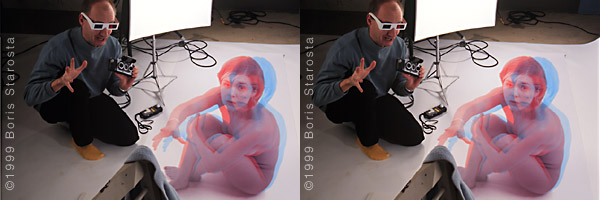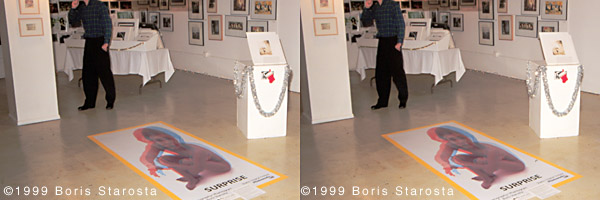Special Project: The Phantogram SURPRISE
A phantogram is a special kind of print that projects the 3-d image of an object out into the space in front of (or on top of) the printed surface. As such, a phantogram presents the three dimensional object without borders. There is no "window" through which the 3-d is perceived. This heightens the sense that the object is a part of the greater reality surrounding the observer - the illusion of three dimensional realism is strengthened; the three dimensional image becomes more tangible.
Figure 1. Shooting SURPRISE shows a floor-mounted print commonly called a phantogram, more technically an anaglyphic stereoanamorphograph. However, one can hardly say "commonly" as this type of print is unusual: I've seen small phantograms in technical books on 3-d geometry/mathematics, and they may occasionally show up in books about stereo imaging. Reel-3D sells a book on how to draw phantograms, although I've not read it. My interest in this stereo format was rekindled when I saw a phantogram by Achim Bahr printed on the cover of a recent issue of STEREOSCOPY magazine, the official journal of the International Stereoscopic Union.

Figure 1. Shooting SURPRISE. Cross-eyed stereo pair of the artist posing with his phantogram SURPRISE. To see how the phantogram might appear to you "in person," view this stereo pair cross-eyed WITH a set of anaglyph glasses.
Shooting SURPRISE is a self-referential strange logic loop, as it shows somewhat humorously a studio setting, in which I am shooting the very pose that is presented in the print - I am shooting the print, which shows the image that was shot in the studio in order to make the print. (I admit that I am a fan of M.C. Escher.)SURPRISE is an inkjet print about 3 x 7 feet in size. It is designed to be viewed at an oblique angle: you stand at one end, with the print stretching away from you resting on the floor. Figure2. Downtown Artspace shows the print installed at the Charlottesville art gallery of the same name. There is a "sweet spot," from which point the three dimensional image can be viewed without distortion - and with surprising realism. In the gallery this spot was marked with an X on the floor and an anaglyph viewer hanging from the ceiling. Figure 1. Shooting SURPRISE was taken from this sweet spot, and gives you a small taste of how the print and its 3-d image appear in real life. I do not know that another print like this has ever been made: a life-size human figure presented as a phantogram. Quite possibly this print is absolutely unique in the world.

Figure 2. Downtown Artspace. The print installed in the gallery in downtown Charlottesville, VA, December, 1998.
How was the image made?
The phantogram image was created from a standard photographic stereo pair image using digital manipulation. The most complex part of this manipulation is the distortion: It has to be a perfect progressive perspective distortion, and cannot be done just using a 2-d perspective tool, such as the one in photoshop.I shot the model with my 35mm twin camera rig, in a very standard fashion (slide #3. Brandi 720). I then scanned the slides (drum scanner) to high resolution files, and took these scans into my favorite "3-d" software - Bryce. There I used the scans as "gels" within light sources that projected the image back down onto a virtual "floor." This projected image I rendered as the print. The geometry was very important, and I had taken careful notes and measurements during the photo session, so as to be able to recreate the geometric relationships of object / camera / and floor (print) with great precision within my computer model.
In essence, I used the computer to reverse the flow of light, from the film plane, back out through the lenses, past the 3-d image (the object), and onto the print. The print thus became the "shadow" of my subject, with the cameras functioning as lights. It is from this same position (the camera's position) that the final print must be viewed, in order to reconstruct the three dimensional image properly. The camera's position defines the sweet spot.
I will admit this description is a bit simplified. There were a number of technical details that needed to be solved, with respect specifically to the use of the Bryce software, registration of the two viewpoints, removal of keystone distortion, color control at the print stage (my thanks to Ray Zone for invaluable advice!) etc. Lots of small fires to put out over the span of a week.
Once I finally had the print made, the illusion was even better than I imagined it would be. It is a "windowless" stereoscopic experience, about as close to virtual reality as I've seen (in some ways much better than looking at a slide). It really makes for an ultimate anaglyph. My thanks go out to Jeff Kilmer at PhotoWorks of Virginia, who sponsored the print for me. His attention to detail and personal interest in the project were critical to the ultimate success of the print.
Next project: Gallery Exhibits
|- H o m e -|- P o r t r a i t s -|- T E C H N O B O T -|- C O M W O R K -|
Unless otherwise noted, all contents of this page, individual or aggregate, are copyright 1999 Boris Starosta. All rights reserved. Unauthorized duplication is a violation of applicable laws, and is destructive of free enterprise, creative expression, and the human spirit. All other product names mentioned in these pages are used for identification purposes only, and may be trademarks or registered trademarks of their respective companies, and the exclusive property of their respective owners.